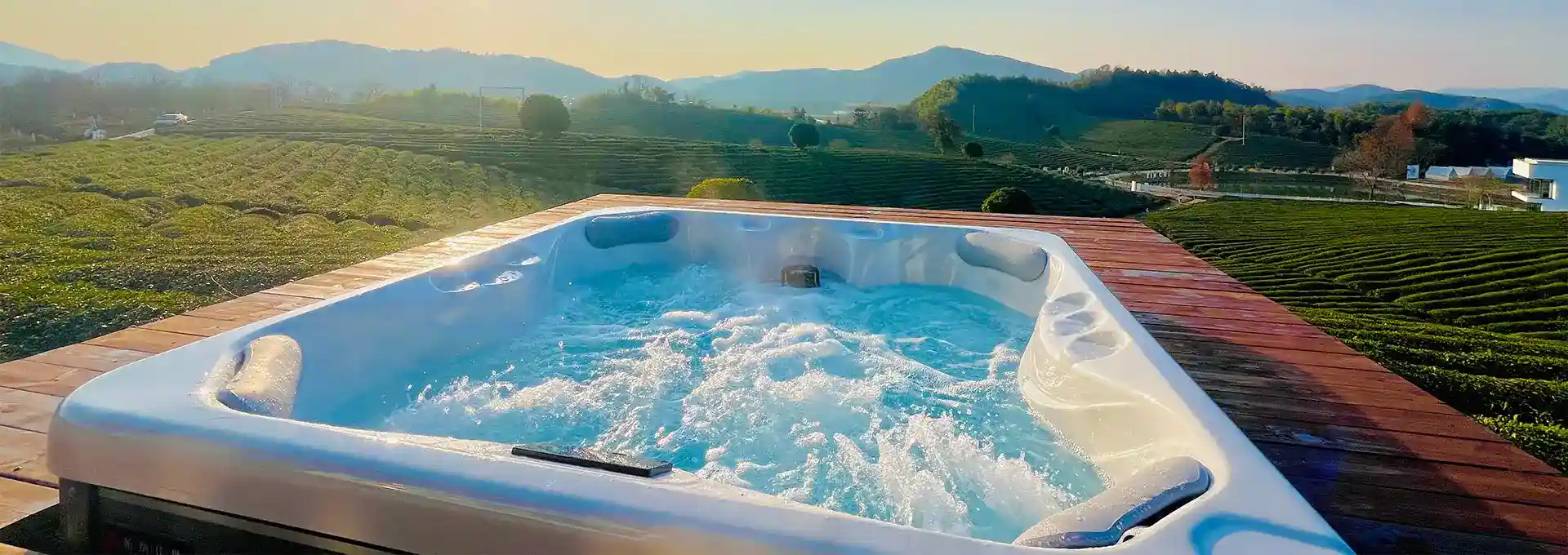What are the Best Practices for Winterizing a Outdoor Swimming Spa to Protect it From Damage?
2025-02-24 14:18:11
As the cold winter months approach, it's crucial to properly winterize your outdoor swim spa to protect it from potential damage caused by freezing temperatures and harsh weather conditions. Winterizing your spa involves a series of steps to ensure that all components are safeguarded and the water system is properly drained and protected. By following best practices for winterization, you can extend the life of your spa, prevent costly repairs, and ensure it's ready for use when warmer weather returns. In this blog post, we'll explore the essential steps and considerations for effectively winterizing your outdoor swimming spa.
How do you drain and clean a spa for winter?
Draining and cleaning your spa is a crucial first step in the winterization process. This ensures that no water is left in the system to freeze and potentially cause damage. Here's a comprehensive guide on how to properly drain and clean your spa for winter:
- Turn off the power: Before beginning the draining process, make sure to turn off all power to the spa at the circuit breaker. This is a vital safety measure to prevent any electrical accidents.
- Locate the drain valve: Most spas have a main drain valve, usually located at the bottom or side of the spa. Consult your owner's manual if you're having trouble finding it.
- Attach a garden hose: Connect a garden hose to the drain valve. Ensure the other end of the hose is positioned where you want the water to drain, away from your home's foundation and any areas that might be damaged by the water flow.
- Open the drain valve: Once the hose is securely attached, open the drain valve to begin emptying the spa. This process can take several hours, depending on the size of your spa.
- Remove remaining water: After the main draining is complete, use a wet/dry vacuum or sump pump to remove any remaining water from the footwell, jets, and other crevices.
- Clean the spa shell: With the spa empty, this is an ideal time for a thorough cleaning. Use a non-abrasive, spa-safe cleaner to scrub the entire shell, paying special attention to the waterline and any areas that may have accumulated dirt or grime.
- Clean and remove filters: Take out the spa filters and clean them thoroughly. If they're old or showing signs of wear, consider replacing them before the next season.
- Blow out the lines: Use a shop vac or air compressor to blow out any remaining water from the plumbing lines. This step is crucial to prevent freezing and potential pipe damage.
- Clean and dry the cover: While the spa is empty, take the opportunity to clean and condition your spa cover. Use a vinyl cleaner and protectant to keep it in good condition.
- Sanitize the system: Before refilling (if you plan to use the spa during winter) or closing up for the season, run a sanitizing solution through the system to eliminate any bacteria or biofilm that may have built up.
By thoroughly draining and cleaning your swim spa, you're not only protecting it from winter damage but also ensuring a fresh start when you're ready to use it again. This process also gives you the opportunity to inspect various components and identify any potential issues that may need addressing before the next use.
What chemicals should be added to a spa for winter?
Even if you're not planning to use your swim spa during the winter months, it's important to properly treat the water to prevent damage and ensure it's ready for use when spring arrives. The right chemical balance can protect your spa's components and make the reopening process much smoother. Here's a guide to the chemicals you should consider adding to your spa for winter:
- pH Balancer: Before adding any other chemicals, ensure your spa's pH level is between 7.2 and 7.8. This is crucial for the effectiveness of other chemicals and to prevent corrosion or scaling.
- Alkalinity Increaser: Total alkalinity should be between 80-120 ppm. Proper alkalinity helps stabilize pH levels and prevents rapid fluctuations.
- Calcium Hardness Increaser: Maintain calcium hardness between 150-250 ppm to prevent damage to your spa's surface and equipment.
- Chlorine or Bromine Shock: Even if you're closing your spa for the season, a final shock treatment will help eliminate any remaining contaminants.
- Non-Chlorine Shock: This can be used in addition to or instead of chlorine/bromine shock, especially if you're sensitive to chlorine.
- Enzyme Treatment: Adding an enzyme treatment can help break down organic contaminants and reduce the formation of scum lines.
- Metal Sequestrant: If your water source contains high levels of metals, a sequestrant can help prevent staining and scaling.
- Antifreeze (for complete winterization): If you're fully winterizing your spa and live in an area with extremely cold temperatures, consider adding a spa-safe antifreeze to your plumbing lines after draining. This provides an extra layer of protection against freezing.
- Winter Float: For spas that will retain some water over winter, a winter float with slow-release chemicals can help maintain water quality.
- Scale Preventer: This can help prevent scale buildup on your spa's surfaces and in the plumbing, which can be particularly problematic during periods of disuse.
It's important to note that the specific chemicals and quantities needed may vary depending on your spa's size, the current water condition, and your local climate. Always follow the manufacturer's instructions and consider consulting with a spa professional for personalized advice.
If you plan to use your spa intermittently during the winter, you'll need to maintain regular chemical treatments. In this case, test the water weekly and adjust chemicals as needed. Keep in mind that chemical reactions may occur more slowly in colder temperatures, so you might need to adjust your treatment schedule accordingly.
Remember, proper chemical balance not only protects your spa but also ensures safe and comfortable use. If you're unsure about the right chemical balance for your spa, don't hesitate to consult with a professional or refer to your spa's manual for specific guidelines.
How do you insulate a spa for winter use?
If you plan to use your swim spa during the winter months, proper insulation is crucial to maintain water temperature, reduce energy costs, and protect your spa from the harsh elements. Here's a comprehensive guide on how to effectively insulate your spa for winter use:
- Check and upgrade your spa cover: Your spa cover is the first line of defense against heat loss. Ensure it fits snugly with no gaps, and consider upgrading to a thicker, more insulated cover if your current one is old or worn. Look for covers with a high R-value, which indicates better insulation properties.
- Install a thermal blanket: A floating thermal blanket placed directly on the water surface can significantly reduce heat loss and evaporation. These blankets are easy to remove when you want to use the spa and can be trimmed to fit your spa's exact dimensions.
- Insulate the cabinet: Many spas come with insulated cabinets, but you can add extra insulation for improved efficiency. Use foam insulation boards or spray foam to fill any gaps or spaces within the cabinet. Be careful not to block any vents or access panels.
- Check and replace perimeter insulation: Inspect the insulation around the perimeter of your spa. If it's compressed or damaged, replace it with new foam insulation to maintain an effective thermal barrier.
- Insulate plumbing lines: Wrap exposed plumbing lines with pipe insulation or heat tape. This is particularly important for pipes that run outside the spa cabinet or are exposed to cold air.
- Install a wind barrier: If your spa is in an open area, consider installing a wind barrier. This could be a fence, lattice, or even strategically placed plants. Reducing wind exposure can significantly decrease heat loss.
- Use an insulated ground mat: Place an insulated mat underneath your spa to prevent heat loss through the bottom. This is especially important if your spa is placed on a concrete pad or deck.
- Maintain consistent water temperature: While it might seem counterintuitive, maintaining a consistent water temperature can be more energy-efficient than allowing it to cool and then reheating. Find a comfortable temperature and maintain it throughout the winter.
- Consider a spa blanket box: A spa blanket box is a cover lifter with an enclosed storage area for your spa cover. This not only makes it easier to remove and replace the cover but also protects it from the elements when the spa is in use.
- Upgrade your pump and heater: If your spa is older, consider upgrading to more energy-efficient pumps and heaters. Modern equipment can significantly reduce energy consumption while maintaining optimal water temperature.
- Use timers for circulation: Set your circulation pumps on timers to run during off-peak electricity hours. This can help reduce energy costs while ensuring proper water circulation and filtration.
- Regular maintenance: Keep up with regular maintenance to ensure all components are working efficiently. Clean filters, check for leaks, and address any issues promptly to prevent heat loss and energy waste.
Remember, the goal of insulating your spa for winter use is not just about keeping the water warm, but also about energy efficiency. A well-insulated spa will require less energy to maintain temperature, saving you money on utility bills and reducing wear on your spa's heating system.
It's also important to consider safety when using your spa in winter. Always keep a path to your spa clear of snow and ice, and be cautious of slippery surfaces around the spa. Have a robe or towel within easy reach to quickly warm up when exiting the spa.
By implementing these insulation techniques, you can enjoy your outdoor spa even in the coldest months while minimizing energy consumption and protecting your investment. Remember to always follow manufacturer guidelines and consult with a professional if you're unsure about any aspect of winterizing or insulating your spa.
Conclusion
Winterizing your outdoor swim spa is a crucial task that protects your investment and ensures your spa will be ready for use when warmer weather returns. By following the best practices outlined in this guide - from properly draining and cleaning the spa, to adding the right chemicals, and insulating it for winter use - you can prevent damage, save on energy costs, and extend the life of your spa.
Remember, the specific needs of your spa may vary depending on your local climate, the spa's design, and your intended use during winter. When in doubt, always consult your spa's manual or a professional for personalized advice. With proper care and winterization, your outdoor swimming spa can provide relaxation and enjoyment for years to come, regardless of the season.
For more information on outdoor swim spa installations and our products, please feel free to contact us at info@iparnassus.com.
References
- Swim University. (2021). How to Winterize an Above Ground Pool.
- Pool Research. (2022). How to Close Your Swimming Pool for Winter.
- Hot Spring Spas. (2021). How to Winterize Your Hot Tub.
- Bullfrog Spas. (2022). How to Winterize a Hot Tub.
- Jacuzzi. (2021). Hot Tub Winterizing Guide.
- Leslie's Pool Supplies. (2022). How to Close an Inground Pool for Winter.
- Hayward Pool Products. (2021). Winterizing Your Pool.
- Pool Supply World. (2022). How to Winterize Your Swimming Pool.
- APSP (The Association of Pool & Spa Professionals). (2021). Winterizing Your Pool.
- Energy.gov. (2022). Energy-Efficient Home Design.



